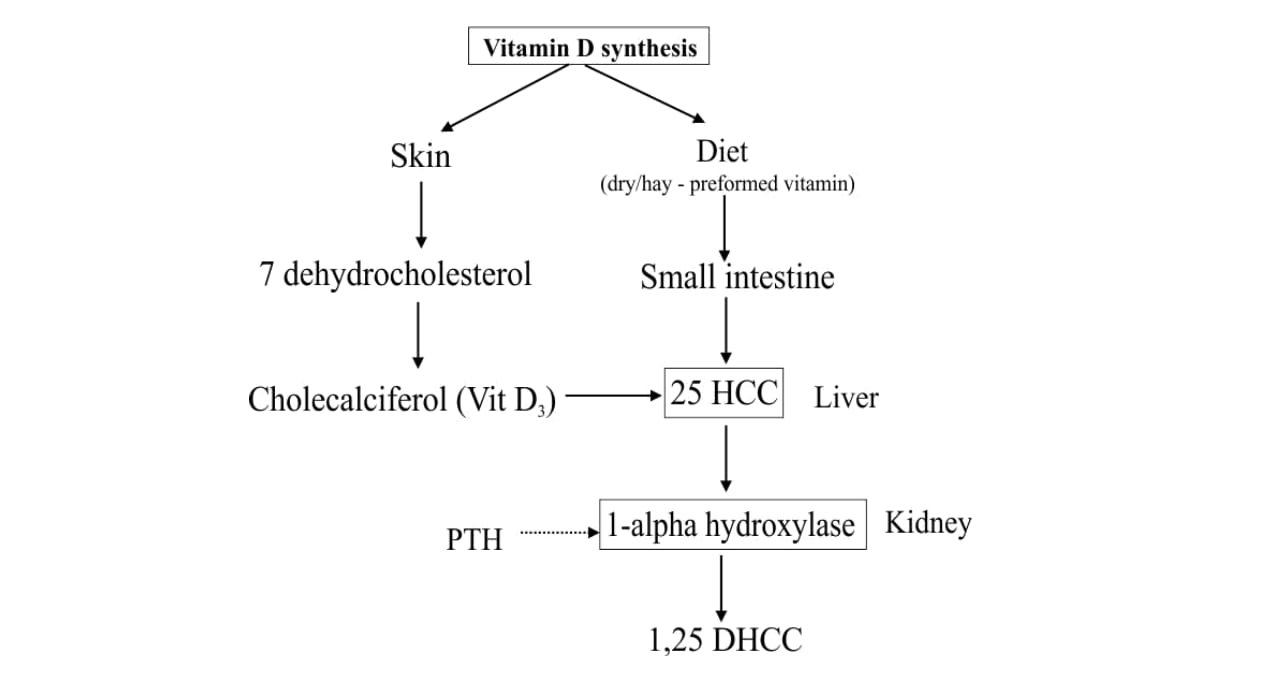Vitamin D Deficiency
Lack of UV irradiation of skin (lack of light / complete intensive rearing animal) cause vitamin D deficiency.
Etiology
- Lack of UV irradiation of skin (lack of light/complete intensive rearing animal).
- Deficiency of preformed Vitamin D in diet:
- Fodder exposed to sunlight for long period – Increase Vit D availability
- Modern hay making – artificial drying of the plant – Decrease Vit D availability
- Green fodder – rich in carotene – it have rachitigenic activity- decrease Vit D utilization
Pathogenesis
Vitamin D is a complex substance with anti-rachitogenic activity and the important component of the Vitamin D is:
- Vitamin D2 – present in the sun dried hay – produced by UV irradiation of plant sterols. Ergosterol is the pro-vitamin of Vit D2.
- Vitamin D3 (Cholecalciferol) – It is produced from its precursor 7 dehydroxy cholesterol in skin and by natural irradiation with UV light. 7 dehydroxy cholesterol is the pro-vitamin of Vit D3.
- Vitamin D4 and D5 occurs naturally in fish oil.
The pro-vitamin Ergosterol and 7 dehydroxy cholesterol have no vitamin value and must be converted into calciferols. For this conversion it is necessary to impart a definite quantity of energy to sterol molecules and this can be brought about by the UV light.
The Cholecalciferol transported to liver to form 25 hydroxy cholecalciferol and produce 1,25 dihydroxycholecalciferol by 1 alpha hydroxylase in kidney. The amount of 1,25 DHCC produced by the kidney is controlled by parathyroid hormone.
When the level of the calcium in the blood is low, the parathyroid gland stimulate to secretes PTH, which induce kidney to produce more 1,25 DHCC and enhance intestinal absorption of Ca+ as well as also enhance reabsorption of Ca+ and P+ in kidney and bones. The conversion of Vit D to active form of Vit D is needs 2-4 days.

Deficiency of Vit D affects normal homeostasis, which leads:
- Affects Ca+ & P+ absorption and reabsorption
- Affects Ca+ and P+ ratio
- Affects bone mineralization
Parenteral administration of Vitamin D to the animal, it will increase plasma Ca+ and P+ level within 12 hours after injection. Hence, it has been recommended to control milk fever in dairy cows.
Clinical signs
- Reduced/ decreased production of the animal
- Decreases appetite and efficacy of food utilization leads poor weight gain
- Reduce reproductive performance
- Lameness
- Young animals – Bending of the long bone and enlargement of joint – Rickets
- Mature/adult animal – Osteomalsia
Diagnosis
- History
- Clinical signs
- Laboratory findings
Laboratory findings
- Serum calcium and phosphorus level: Early stage hypophophatemia followed by hypocalcemia
- Elevated serum ALP
- Plasma Vitamin D
Treatment and control
- Administration of Vitamin D with calcium and phosphorus supplementation.
- Diet: Vitamin D at 7- 12 IU/kg daily PO.
- Vit D2: Calciferol at 1100 U/kg IM single dose (it gives protection for 3-6 months).
- For Sheep at 6000 U/kg, it gives protection for 3 months.
Rickets VS Osteomalacia
| Parameters | Rickets | Osteomalacia |
|---|---|---|
| Epidemiology | Common in young growing animals | Less common in adult / Mature animals |
| Etiology | 1. Deficiency of any one of calcium or phosphorus or Vitamin D and or in combination. 2. Due to high requirement of young animals for their bone development. 3. Calves: Primarily phosphorus deficiency and Vitamin D deficiency. 4. Lambs: Secondary to Vit D deficiency & Less phosphorus. 5. Piglets: Diet excess phosphorus and deficiency of Vitamin D & calcium. | 1. Deficiency of any one of calcium or phosphorus or Vitamin D and or in combination. 2. Not due to high requirement of growth, but drain of calcium/phosphorus in the lactation and pragnancy. 3. Cattle: Mostly phosphorus deficiency & less common calcium & Vitamin D. 4. Sheep: Mostly phosphorus deficiency. 5. Feed lot cattle: Excessive phosphorus diet without complementary supplement of calcium & Vitamin D. |
| Pathogenesis | Deficiency of Calcium, Phosphorus and Vitamin D results defective mineralization of the osteoid and cartilaginous matrix of the developing bone. This leads to hypertrophy of epiphyseal cartilage which increase the width of the epiphyseal plate. It causes bowing of long bone, broadening of epiphyses and enlargement of joints. | Increases reabsorption of bone minerals to supply the needs of pregnancy, lactation and for the body energy metabolism. This leads osteoporosis, weakness and deformity of the bone. It cause tendency to fracture with severe exercise. |
| Clinical Signs | 1. Stiffness. 2. Enlargement of the bones and joints, especially in the for legs. 3. Enlargement of costrochondral junction. Abnormal curvature of the long bones usually forward and out ward at carpua. 4. Lameness 5. Tendency to lie down for long time. 6. Delaying the teeth eruption which leads to tongue protrution and drooling of saliva and difficulty in feeding. 7. Recumbency followed by animal die due to inaniation. | 1. In Cattle: Early stage: lowered production and fertility, licking and chewing of inanimate object. Stiff gait, lameness Shifting from leg to leg Crackling sound while walking and arched back. In severely affected animal: hocks rotated inside. Animal decline to move, lie down for long time and are unwilling to getup. Weakness leads to permanent recumbency and death due to starvation. 2. Pigs: similar to cattle. Recumbent: unable to raise from lateral recumbency. (Dog sitting position) |
| Diagnosis | 1. Increases in ALP level 2. Calcium and Phosphorus level depends on the condition. 3. Early phosphorus level low & in end stage Calcium become low 4. Low serum Vitamin D 5. X-ray: Most valuable, Bone lack of density. | 1. Increases in ALP level 2. Decrease Phosphorus level 3. X-ray: Most valuable, Bone lack of density |
| Tratment and Control | Specific nutrition supplement or Combination of Calcium, Phosphorus and Vitamin D administration. | Specific nutrition supplement |

